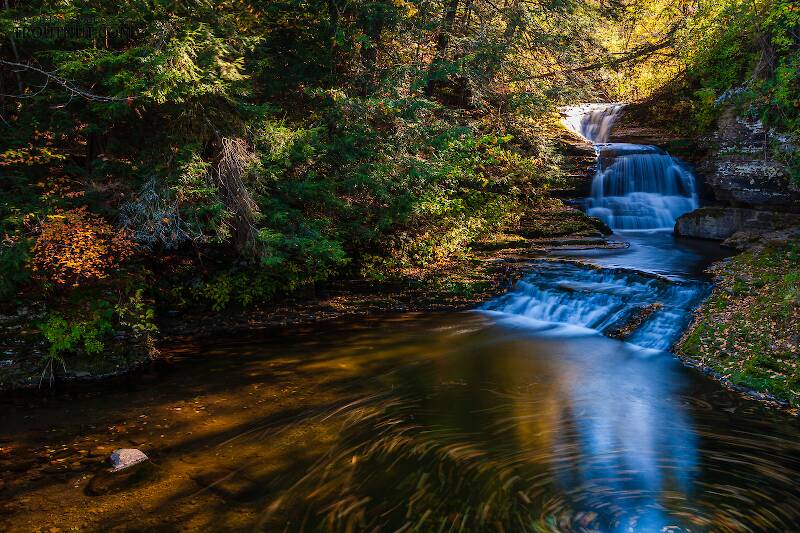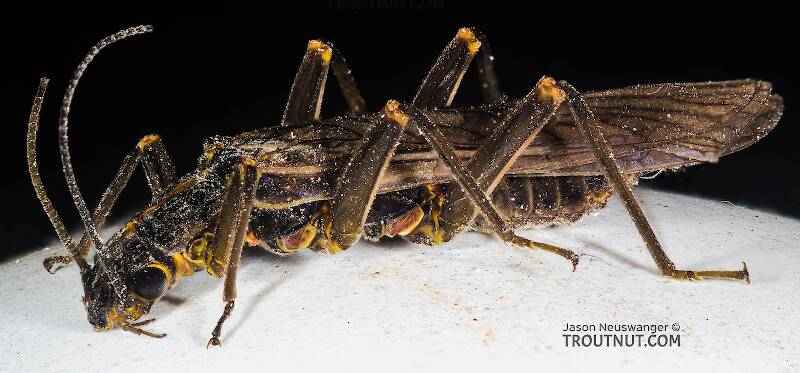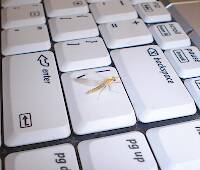
Salmonflies
Pteronarcys californica
The giant Salmonflies of the Western mountains are legendary for their proclivity to elicit consistent dry-fly action and ferocious strikes.
Featured on the forum

Troutnut is a project started in 2003 by salmonid ecologist Jason "Troutnut" Neuswanger to help anglers and
fly tyers unabashedly embrace the entomological side of the sport. Learn more about Troutnut or
support the project for an enhanced experience here.
Troutnut on Jun 5, 2007June 5th, 2007, 1:15 pm EDT
John just posted about a fly from LaFontaine's "The Dry Fly: New Angles" called "the Mess" which I haven't tried, so I don't have any real comments, there, but it reminds me to ask about another fly from that same book. LaFontaine took a very systematic approach to developing the ultimate attractor fly and came up with something called the "Double Wing." I was just tying a bunch of them earlier this morning, and they've become my favorite attractor flies. I tie them in the "royal" color scheme, and they work as well as (if not better than) the Royal Wulff. They're more durable, they always land upright, and they float like a cork but they look good wet if they do get dunked in fast water.
I'm surprised the fly hasn't caught on more. It may be because it takes a little longer to tie than similar attractors, although it's really not that much longer.
I'm surprised the fly hasn't caught on more. It may be because it takes a little longer to tie than similar attractors, although it's really not that much longer.
Jason Neuswanger, Ph.D.
Troutnut and salmonid ecologist
Troutnut and salmonid ecologist
Wiflyfisher on Jun 5, 2007June 5th, 2007, 3:43 pm EDT
Jason, the little time I got to fish with Gary I did notice he seems to really try to understand everything from the trout's point of view, not just from our point of view. This is what intrigues with his writings too.
As much as I love your photography skills and your enthusiasm there is still things missing. When an insect is emerging does it look the same as it does several minutes later? What is it's shape, form and appearance from underneath the water? What triggers a "larger trout" to say this is food? From my experience an emerging mayfly can look much different than when we capture it, put it on ice and then photograph it. I have caught emerging duns in the water and the body colors seldom look like what we see in any books. Gary also mentions female mayflies look different than males because of the eggs inside of the females. Also, he mentioned the bodies have a translucent appearance.
What triggers a trout to accept or reject a fly can still be mind-boggling to me after many years of chasing trout. How does subtle movements, color and silhouette play as key factors to cause a trout to strike a fly? During a subvaria hatch years ago I remember watching a 20" trout refuse everything but a size #14 royal coachman dryfly. In the bright afternoon sunlight did the silhouette of the royal coachman appear more realistic or was the drift more precisely in his feeding lane?
I guess that is what keeps me going back year after year. I have many fond memories of trout that eluded me that I wanted to catch. Was it my presentation or my specially designed fly at fault? Some of these trout burn in my memory and keep me going back.
I personally can't wait to take on the elusive, reel-screaming, silver bullets of the Henry's Fork this summer, they are awesome! They can humble anyone very quickly and at the same time it can be very rewarding for those who are up to the challenge.
As much as I love your photography skills and your enthusiasm there is still things missing. When an insect is emerging does it look the same as it does several minutes later? What is it's shape, form and appearance from underneath the water? What triggers a "larger trout" to say this is food? From my experience an emerging mayfly can look much different than when we capture it, put it on ice and then photograph it. I have caught emerging duns in the water and the body colors seldom look like what we see in any books. Gary also mentions female mayflies look different than males because of the eggs inside of the females. Also, he mentioned the bodies have a translucent appearance.
What triggers a trout to accept or reject a fly can still be mind-boggling to me after many years of chasing trout. How does subtle movements, color and silhouette play as key factors to cause a trout to strike a fly? During a subvaria hatch years ago I remember watching a 20" trout refuse everything but a size #14 royal coachman dryfly. In the bright afternoon sunlight did the silhouette of the royal coachman appear more realistic or was the drift more precisely in his feeding lane?
I guess that is what keeps me going back year after year. I have many fond memories of trout that eluded me that I wanted to catch. Was it my presentation or my specially designed fly at fault? Some of these trout burn in my memory and keep me going back.
I personally can't wait to take on the elusive, reel-screaming, silver bullets of the Henry's Fork this summer, they are awesome! They can humble anyone very quickly and at the same time it can be very rewarding for those who are up to the challenge.
John S.
https://WiFlyFisher.com
https://WiFlyFisher.com
Invicta on Jun 6, 2007June 6th, 2007, 5:40 am EDT
Jason,
I used the double-wing pretty extensively during the early and mid 90’s. I found it to be an adequate attractor, primarily for cutthroat. I also had the opportunity to discuss pattern design with Gary, over dinner, on one of his stays in Los Angeles. He was really definite about the type of water that the double-wing was most successful on, and that was riffles without extremely heavy water. He mentioned that most the time he used it was during a float trip, where you can cover likely looking spots once, or twice, then move on. This fit with the experience I had with the pattern, though I found I had equal success with an appropriately sized and colored Stimulator. I found I could improve my success with the double-wing by changing the calf tail fore-wing, and passed the change onto Gary. I don’t think he ever made mention of the alteration in print.
What I did was to treat the calf tail with commercial hair process (the stuff that makes naturally curly hair straight) by the label instructions. When the tail is washed off and dried you have straight, translucent, really shiny calf hair (it looks very similar to fine structured polar bear hair). Used as wing material only synthetics were more brilliant. The advantage in using this hair was that I could tie a much smaller size and still maintain the sparkle appearance of the wing that Gary thought important. I stopped using the double-wing when the waters I fished required more of a stealthy approach, and patterns that were more suggestive, though I still carry a couple with me in smaller sizes. You never know…
John
I used the double-wing pretty extensively during the early and mid 90’s. I found it to be an adequate attractor, primarily for cutthroat. I also had the opportunity to discuss pattern design with Gary, over dinner, on one of his stays in Los Angeles. He was really definite about the type of water that the double-wing was most successful on, and that was riffles without extremely heavy water. He mentioned that most the time he used it was during a float trip, where you can cover likely looking spots once, or twice, then move on. This fit with the experience I had with the pattern, though I found I had equal success with an appropriately sized and colored Stimulator. I found I could improve my success with the double-wing by changing the calf tail fore-wing, and passed the change onto Gary. I don’t think he ever made mention of the alteration in print.
What I did was to treat the calf tail with commercial hair process (the stuff that makes naturally curly hair straight) by the label instructions. When the tail is washed off and dried you have straight, translucent, really shiny calf hair (it looks very similar to fine structured polar bear hair). Used as wing material only synthetics were more brilliant. The advantage in using this hair was that I could tie a much smaller size and still maintain the sparkle appearance of the wing that Gary thought important. I stopped using the double-wing when the waters I fished required more of a stealthy approach, and patterns that were more suggestive, though I still carry a couple with me in smaller sizes. You never know…
John
Troutnut on Jun 6, 2007June 6th, 2007, 6:59 am EDT
Interesting hair treatment technique. I've been using a bit of white hi-vis right underneath the calf hair to give it that sparkle. That seems to work really well, although I haven't empirically tested it against other variations.
Jason Neuswanger, Ph.D.
Troutnut and salmonid ecologist
Troutnut and salmonid ecologist
Invicta on Jun 6, 2007June 6th, 2007, 1:16 pm EDT
Jason,
I tried HiViz, Antron, and Zlon fibers in the wing also, and they worked well in the larger sized hooks. However, I found that the wing had a tendency to separate into separate fiber ‘clumps’ after being wetted, which wasn’t what I wanted. Using only the treated hair makes the entire wing sparkle, which I thought was a benefit for an attractor. Though not the intended purpose, the treated hair has given me a way out of using synthetics when I want a flashy wing. It also turns out that the hair treatment changes the structure of the calf hair fiber allowing further dye procedures to produce really brilliant colors that I have used in steelhead and salmon patterns. And with relatively straight calf hair fibers you can actually use a hair stacker with success.
John
I tried HiViz, Antron, and Zlon fibers in the wing also, and they worked well in the larger sized hooks. However, I found that the wing had a tendency to separate into separate fiber ‘clumps’ after being wetted, which wasn’t what I wanted. Using only the treated hair makes the entire wing sparkle, which I thought was a benefit for an attractor. Though not the intended purpose, the treated hair has given me a way out of using synthetics when I want a flashy wing. It also turns out that the hair treatment changes the structure of the calf hair fiber allowing further dye procedures to produce really brilliant colors that I have used in steelhead and salmon patterns. And with relatively straight calf hair fibers you can actually use a hair stacker with success.
John
Troutnut on Jun 6, 2007June 6th, 2007, 3:31 pm EDT
Sounds like something to try!
Jason Neuswanger, Ph.D.
Troutnut and salmonid ecologist
Troutnut and salmonid ecologist
Shawnny3 on Jun 7, 2007June 7th, 2007, 12:25 am EDT
Although I don't use a lot of synthetic fibers, I have found this discussion really interesting. I really like the straightening technique described (developed?) by John. I'm left debating how many more hair products I have to own before I become a woman.
Finally, the Tying Forum looks like it's taking off a little!
-Shawn
Finally, the Tying Forum looks like it's taking off a little!
-Shawn
Jewelry-Quality Artistic Salmon Flies, by Shawn Davis
www.davisflydesigns.com
www.davisflydesigns.com
Invicta on Jun 7, 2007June 7th, 2007, 3:36 am EDT
I really don’t know if I was the first to discover the calf tail technique, but I can say that I developed it independently. This came about the same time that I discovered using ‘Woolite’ will clean and aid in restoring the “marrying” quality of Golden Pheasant Tail fibers for Atlantic Salmon patterns. Large GP tail feathers get dusty and worn, without help they really don’t make an acceptable wing on classic patterns. A couple of authors borrowed this idea in the late 90’s. No big deal, at least the idea was shared.
John
John
Shawnny3 on Jun 8, 2007June 8th, 2007, 1:19 pm EDT
I read about the Woolite in Mark Radencich's book on classic salmon flies - nice to know where the idea came from. I'm doing an interesting project on artistic salmon flies - perhaps you wouldn't mind giving me your opinion of it when it's ready, John. I can already tell from you're few posts here that you're someone who really knows what he's talking about.
-Shawn
-Shawn
Jewelry-Quality Artistic Salmon Flies, by Shawn Davis
www.davisflydesigns.com
www.davisflydesigns.com
Invicta on Jun 8, 2007June 8th, 2007, 5:04 pm EDT
Shawn,
Thanks very much for the kind words. I’d be honored to help out in any way possible. If you don’t mind a PM I’ll pass on some of my background in classic salmon patterns, its entertaining if nothing else.
John
Thanks very much for the kind words. I’d be honored to help out in any way possible. If you don’t mind a PM I’ll pass on some of my background in classic salmon patterns, its entertaining if nothing else.
John
JOHNW on Sep 16, 2007September 16th, 2007, 10:43 am EDT
Bump to the top for reference!
JW
JW
"old habits are hard to kill once you have gray in your beard" -Old Red Barn
Oldredbarn on Oct 19, 2011October 19th, 2011, 7:07 am EDT
Fellas...I'm going to follow Johns idea here from 2007 and bump this one back up into the loop. It is an interesting thread.
Jason...I have a good friend that is very fond of the double-wing and has been trying to get me interested for some time now. He stayed with us last spring when he was here in the area for a fly tying expo and we spent a few nights down in the basement tying flies etc. He tied up a couple for me as models.
I think that we humans have a tendency to get "set-in-our-ways" and are at first reluctant to try something different. LaFontaine seems to be one of those guys, maybe like Gartside was, that wasn't happy with settling and was always pushing the envelop a bit.
His ideas about different light qualities/frequencies and the colors we shoud use for different times of day and light conditions is really interesting. In other threads I have made mention of problems with photographing my finished flies and there has to be some of this physics I'm missing...
Another thing...Where has Wiflyfisher and Invicta been hiding these days? I know John has his own site and all but he used to nose around here more often.
Spence
Jason...I have a good friend that is very fond of the double-wing and has been trying to get me interested for some time now. He stayed with us last spring when he was here in the area for a fly tying expo and we spent a few nights down in the basement tying flies etc. He tied up a couple for me as models.
I think that we humans have a tendency to get "set-in-our-ways" and are at first reluctant to try something different. LaFontaine seems to be one of those guys, maybe like Gartside was, that wasn't happy with settling and was always pushing the envelop a bit.
His ideas about different light qualities/frequencies and the colors we shoud use for different times of day and light conditions is really interesting. In other threads I have made mention of problems with photographing my finished flies and there has to be some of this physics I'm missing...
Another thing...Where has Wiflyfisher and Invicta been hiding these days? I know John has his own site and all but he used to nose around here more often.
Spence
"Even when my best efforts fail it's a satisfying challenge, and that, after all, is the essence of fly fishing." -Chauncy Lively
"Envy not the man who lives beside the river, but the man the river flows through." Joseph T Heywood
"Envy not the man who lives beside the river, but the man the river flows through." Joseph T Heywood
Quick Reply
Related Discussions
Topic
Replies
Last Reply
5
Dec 24, 2007
by Martinlf
by Martinlf
5
Jun 14, 2008
by Wiflyfisher
by Wiflyfisher







